Editor’s Note: As we navigate a new normal amid the coronavirus pandemic, these are tried and true eCommerce marketing strategies and methods that have proven effective even as businesses change. We are adapting to the short-run, however, the importance of having longer-term strategies in place ensures longer-term business success and health. Here are additional resources to help you navigate your marketing strategy during this time.
If you go to Google and search “eCommerce Marketing Strategy,” you’re more than likely to turn up articles that provide beginner-friendly and surface-level advice.
While these posts are useful for people getting started with their first online store, merchants with established businesses need to know about specific marketing strategies they can use to gain a competitive edge.
In other words: You already know that using tactics such as pay-per click (PPC) campaigns, search engine optimization (SEO) and conversion rate optimization (CRO) are important in general.
What you actually need to know are specific digital marketing strategies that work right now to aid your marketing efforts.
The 9 eCommerce marketing strategies below are tailored toward medium to large businesses, but they will also work for a small business, too. Whether you implement one strategy, or all of them, into your eCommerce marketing plan, your store’s performance will improve.
Note: Want to talk to someone who can help with your eCommerce store’s digital marketing? Get in touch.
eCommerce PPC Marketing Strategies

#1: Use a “See, Think, Do” Social Media Ads Strategy
The cost of ads on social media platforms is rising steadily. To get a great return on ad spend (ROAS) depends on generating purchases while minimizing ad spend. This means finding new, cold audiences with a high ROAS.
Segmenting and optimizing social media ads to each stage of the marketing funnel is key.
Some stores can take a bottom of the funnel only approach to their ads to get a return, without focusing on converting a cold audience. However, this is not true for all online stores. Ideally, your store can test a full funnel strategy like the one we outline below against a bottom of the funnel (BOFU) campaign and come to a clear conclusion.
The full funnel that a customer goes through prior to a purchase is generally outlined as Awareness, Interest, Desire, and Action.
In the context of paid social media ads, we’ve found great use from reframing the marketing funnel under Avinash Kaushik’s ‘See, Think, Do’ business framework for categorizing prospects along their buying journey.
Note: Below is the definition for each stage of this framework, and a real Facebook Ads campaign we applied it to for a client that got a 10x ROAS.
“See”: The largest possible audience that would buy your products, but haven’t shown intent.
For the “See” audience, we want to inexpensively get targeted prospects to the website and looking at your products.
- Goal: Cheap impressions at scale
- KPI: Cost per mille (CPM)
- Ads: Brand awareness to introduce the store and/or products (“Reach” in Facebook Ads Manager)
“See” Ad Example:

“Think”: A subset of the ‘See’ audience who have shown intent by engaging.
For the “Think” audience, we want to show the prospects who engaged with your ad the same products that they showed interest in on their last visit. We collect them as a custom audience using a Facebook Ads pixel.
- Goal: Landing page views
- KPI: Cost Per Engagement (CPE)
- Ads: Remarketing product ads based on engagement / products viewed (“Conversion” as the campaign objective in Facebook Ads Manager)
“Think” Ad Example:

“Do”: A subset of the ‘Think’ audience who are the most likely group to buy because they shopped for the longest amount of time.
After the past two stages, we attained a 10x ROAS for the ‘Do’ stage ads that we created for this client. The key thing we did was retarget the top 25% of landing page website visitors from the “Think” stage based on how much time they spent on site.
- Goal: Conversions
- KPI: Cost per purchase
- Ads: Retargeting ads to the top 25% of the “Think” audience based on time spent on site, with bold graphics, copy, and calls to action (CTAs).
“Do” Ad Example:

You can scale Facebook ads performance just like this by structuring campaigns to bring in new potential customers at the top of the funnel, and then filter only the most engaged prospects down the funnel to a purchase.
Note: Check out the original post with the full details of our ‘See, Think, Do’ eCommerce Facebook Ads strategy here.
#2: Use Facebook Ads and Google Ads Together
With a limited ad budget, eCommerce merchants often assume that they have to choose between Facebook Ads and Google Ads (formerly Google Adwords).
In reality, your business can probably use a cross channel advertising strategy that incorporates both platforms. Though, you may scale ads on one channel more than the other.
eCommerce companies can maximize their brand exposure, conversions, and profitability from PPC by using Facebook Ads and Google Ads together strategically.
What does this complementary strategy look like?
How Facebook Ads and Google Ads Complement Each Other

Facebook (and Instagram) are great for getting new audiences on social media exposed to your brand.
This added brand awareness can create more branded searches for your brand and products in Google, which helps signal to Google that they should associate your website with your brand.
As Google recognizes your brand as an entity, it helps add traction to your branded search marketing campaigns, ensuring that you show up at the top when people search for your brand. Including brand+keyword search terms like “annemarie body lotion:”
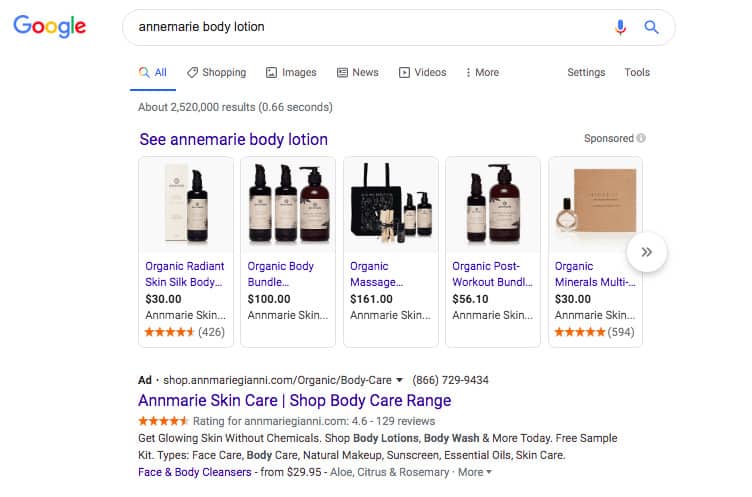
As audiences continue engaging with your Website and Facebook Business Page, you can remarket to them across the web through Google’s Display network and Facebook’s pixel.
To get the full details on using this multi-channel strategy, see our guide to Google Ads vs Facebook Ads for eCommerce.
#3: Optimize Your Product Data Feed
When we onboard new PPC clients, reviewing their product data feed is a crucial step of our initial audit. If products don’t have enough data, or are missing from the product feed altogether, this leads to missed opportunities for better Shopping Ads performance.
An unoptimized feed makes it harder for your products to appear when buyers search for them. It also leads to wasted ad spend. We often see a particularly high volume of low converting search queries being triggered in product listing ad (PLA) campaigns as a result of an unoptimized data feed.
As an absolute bare minimum, add in a featured image for your product, pricing, and availability to make sure you show up in Google Shopping’s product feed.
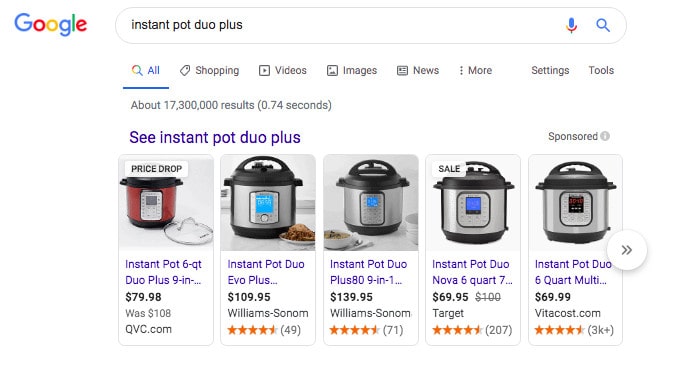
The more information you add about each of your products in the feed, the more Google will show them, and the more they will stand out from the competition.
Optimizing the data feed with as much information as possible will not only make your shopping listing look more appealing to customers, but it will also allow Google to show your product for more relevant results. This helps avoid wasting ad spend on irrelevant search queries.
We recommend optimizing your product data feed by following these best practices. Foremost among them:
- Adding all your products to your product feed (not just some).
- Optimizing the products in the feed with as much relevant information as possible (colors, patterns, scents, size, weight, etc.).
Note: In addition to helping with PPC, clean product data feeds are also critical for optimizing the quality of search engine traffic your eCommerce website gets.
If you really want to take this to the next level, we recommend going with a data feed optimization platform. We use Feedonomics for most of our clients and tend to see a noticeable increase in performance fairly immediately.
eCommerce CRO Marketing Strategies
#4: Personalize Your Shopping Experience to Each Audience Segment
The growth of microbrands is already encroaching quite a bit on the bottom line of consumer giants. Often, these smaller brands cater their entire shopping experience to very specific, niche audiences.
As a result, the little guys are able to beat out the big brands for those niche customers.
The process for personalizing the shopping experience of your eCommerce business can be boiled down to bucketing your audience segments into customer personas, and giving each persona a tailored user experience.
For example, our client with a used photography equipment marketplace provides separate shopping experiences for their prospects who want to buy equipment, sell equipment, or get equipment repaired. They built out separate sections of their website to cater to each prospect’s intention.
There is no one-size-fits-all with how to do eCommerce personalization. It will vary based on your customer personas and the way these different users behave on your site. So first, you have to do some research and collect that data. Then, use that information to personalize your website.
The steps to personalizing your eCommerce website’s shopping experience are:
- Brainstorm and group personas together from your overall customer base.
- Identify the characteristics and site behaviors specific to each persona.
- Track and analyze that data with Google Analytics Custom Dimensions.
- Narrow down the 3-5 data points that are the specific actions usually taken by each persona (this requires more testing and analyzing to confirm).
- Personalize your website accordingly.
Want to see how to complete each of the above steps in detail? See our full guide to eCommerce personalization strategies.
#5: Optimize Shopping Cart and Checkout According to Best Practices
We still see eCommerce businesses that have yet to adopt common conversion rate optimization best practices for their cart and checkout pages.
Here are the CRO tips we recommend testing that even big stores miss:
Best Practice #1: If most purchases on your website are for one item, make sure to send users straight to the cart.
Best Practice #2: On the other hand, if you typically sell more than one item per order, keep users on the product page and encourage them to keep shopping. For example, Gap shows the dollar amount customers have left to spend to qualify for free shipping:

Best Practice #3: Don’t display a coupon code field in the checkout process by default. Most businesses display the field for customers to enter a coupon or promo code. For example, Tani’s checkout flow displays the coupon code field by default:

Our testing for some clients has shown increased cart abandonment when the checkout flow displays this field by default versus hiding it. This suggests that some customers may have been abandoning the checkout page to search for a code to use after seeing the blank field.
A better option may be to do what PACT Organic does in their checkout flow. Which is to ask the customer if they have a coupon first:
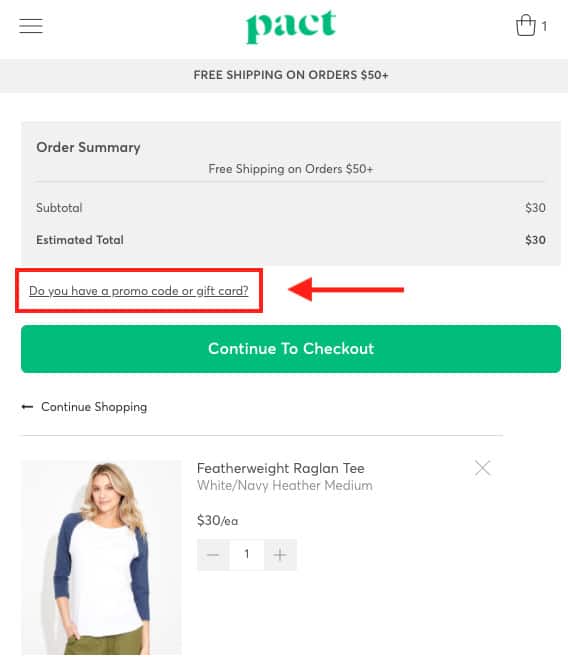
Once the customer clicks that text to confirm they already have a code, the field to enter it drops down for them to use:
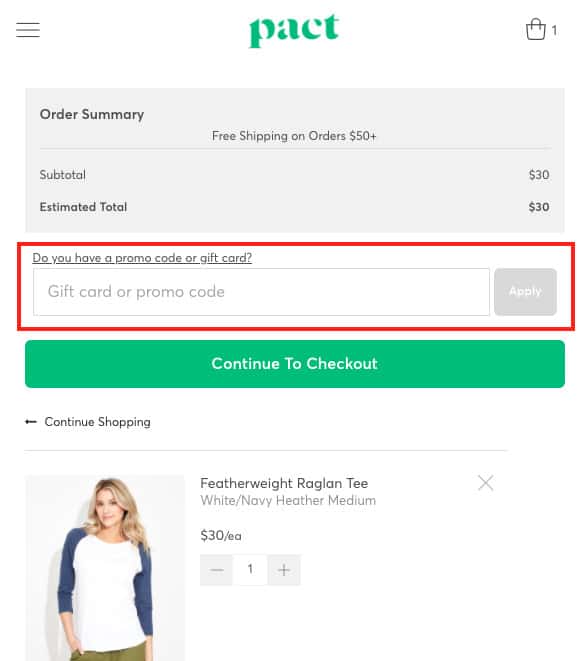
Be sure to test one version of the checkout flow on your site with the field hidden, and one with the field displayed. See if hiding the field results in less cart abandonment and if so, make that the default option.
Best Practice #4: Keep your checkout process limited to as few steps as possible, and keep it distraction-free by eliminating unnecessary sections such as your website navigation header. The only visible elements that should be there are the ones necessary to complete their purchase. In general, this best practice is commonly known, yet we have seen that some stores still have cluttered or distracting checkout processes.
Best Practice #5: Display an order summary throughout the checkout process that lets customers easily see that they got the correct items. People will sometimes abandon the checkout and go back to the cart if they don’t see their entire order displayed and want to double check something. For example, Aquasana keeps the shopping cart items visible at the top while taking payments, with a link to go back to the cart if they need to.

#6: Display and Test Trust Elements on Your Website
Trust elements are proven to help reassure customers and increase conversion rates. These include graphics such as:
- Security seals
- 3rd party verification badges
- Industry certifications
That said, we have tested trust seals and badges and found that what “trust” means for one brand and their customers may differ for another brand.
Different industries, businesses, and their customers come from different backgrounds, and have different values and needs when shopping. This is why the best way to validate which trust symbol works best for you is through controlled testing on your website.
One test we usually recommend running is to include trust elements throughout the customer journey (on your homepage, catalog, and especially in cart/checkout). This helps to reassure customers at each step because the element is on every page.
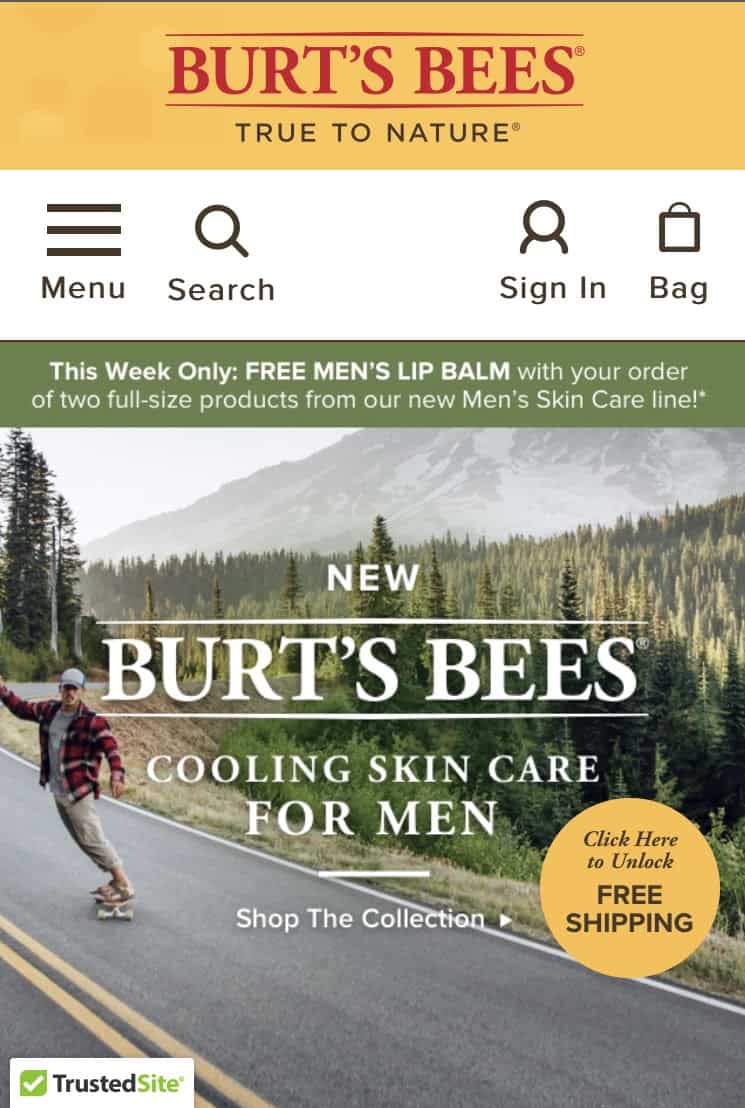
We have linked trust certifications to increased conversions through our own independent testing below (which commonly includes a control group with no certification preset on the site):
In both of them, the major factors are the website the trust badge appears on and the company behind the trust badge itself.
To start, test out the best trust badges for eCommerce and find what works best. Or hire a conversion rate optimization specialist to test what works best on your behalf.
Note: In addition to the strategies above, you can see more effective CRO strategies in our annual CRO study of the best-in-class eCommerce stores.
eCommerce SEO Marketing Strategies
#7: Scale Strategic Content Marketing
eCommerce businesses can see a direct ROI from publishing strategic content such as buyer guides, resources, and how-to articles. The other benefit of scaling high-quality content is that it can dramatically improve the SEO quality of your website.
To scale high-quality content for inbound marketing you can:
- Hire it out to an agency’s content marketing team
- Hire a Senior Content Manager in-house to manage your own portfolio of freelance writers
- Work with a freelance content marketing consultant with their own team of writers and editors
As a general guideline, make sure the content is tailored to your audience:
- What are your customer’s questions about your products?
- What are the problems they need help solving that your product can help with?
- What tone and format (e.g. articles, resources, videos) will your customers find engaging based on their personas and interests?
For example, we helped our warehouse industry client publish resources like warehouse-related checklists. Their customers tend to need help stocking and organizing their warehouses. This content helped to solve their problems. As a result, website traffic, signups, and conversions increased.
For other clients, a product buying guide often makes sense. For example, if you sell backyard playsets, a buying guide to the different materials they can be made of, configurations, and safety information is content that potential customers could find engaging.
Overall, make content that is tailored to the specific industries that buy your products. In the next strategy, you’ll learn how to make sure that your strategic content is highly optimized for search engines.
#8: Use Content Optimization Software to Supercharge Your Strategic Content’s Ability to Rank
If you can see what people are searching for and where they’re landing, then you can make sure those pages properly meet the search intent. What does “properly meet the search intent” mean, though?
It means providing the best answer to whatever it is they are hoping to get back from a search term. This is how you get your strategic content to rank higher in Google.
Some search terms indicate that users want to find specific products to buy (“burberry size medium topcoat tan check”). In that case, you want to provide the best product page possible for that Burberry topcoat, with those size/color/pattern modifier words like “medium,” “tan,” and “check” included on the page.
Other search terms indicate that the users have a problem or question they want to solve, like “how to care for leather luggage.” In this instance, you want to provide the best guide online for taking care of leather luggage compared to the competing leather luggage care guides at the top of Google.
We like to use Clearscope as an on-page optimization tool to make sure pages include the right type of content and keywords. It’s especially useful for strategic content like articles and blog posts.

Clearscope provides optimization suggestions based on the common keywords on the top ranking search engine results pages (SERPs). That makes it easy for you to include the right content and keywords for each page.
There are some other well-known content optimization tools out there (that we haven’t tried out), such as Ryte and Copywritely.
Once you know the keywords your customers are using, and have optimized your on-page copy to include them, there are more SEO tweaks that can make a big difference. Be sure to edit your meta tags, and add internal linking on category and product pages to incorporate those keywords in the anchor text.
Note: When optimizing a page for specific keywords like this, your goal is to publish a better version of the top-ranking content that ranks for the target keywords. This process is what doing content marketing for SEO entails in a nutshell.
#9: Add Schema Markup to Get Your Brand and Products Featured by Google
Now it’s time to help all of your content “pop” visually and rank higher in the search engines with Schema markup.
JSON Schema markup is code that indicates what’s on your webpages to search engines. Adding as much structured data as possible helps improve the odds of Google indexing and ranking your web pages higher.
Once Google recognizes the structured data on your pages, this increases the odds of visual elements being added to those pages in the SERPs. This can include beating organic rankings as a featured snippet at the very top of results:
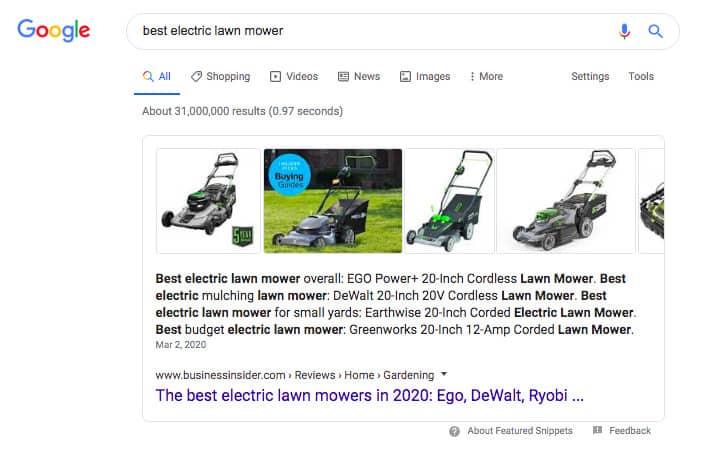
You can generate structured data to add to your page according to Google’s specifications with their Structured Data Markup Helper.
Have a web developer implement the JSON code for relevant markup on your most important pages first, such as your highest trafficked and highest converting pages.
Once you’ve implemented structured data, use Google’s Structured Data Testing Tool to double check it.
Here are some types of structured data eCommerce website should be using:
Products, Pricing, and Availability Schema
Product Schema is important for any eCommerce site to get those products recognized as entities and indexed by search engines.
Adding structured data markup for Pricing, Price Range, and Availability Schema is also important to increase the odds of showing up for “Popular products” results like this:
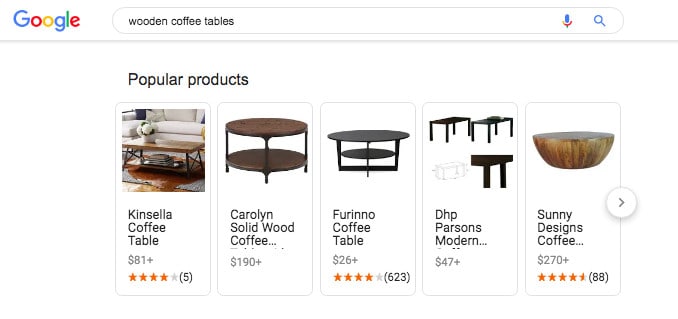
Ratings Schema
As you see in the image above and below, adding markup for ratings helps those nice star ratings to appear in search results.

This markup is built into some eCommerce product review software platforms as well.
Organization Schema
Use Organization Schema to build your brand as an entity in Google. This markup helps to get your logo in Google’s Knowledge Graph.

Questions and Answers
People often input very specific questions about products and brands into Google.
This markup can increase the odds of a Q&A Snippet by telling Google that the page consists of questions and their answers. Such as this one pulled from Amazon:

Or this one pulled from a roofing and insulation supplier:

Video
As video results become more frequent, you can increase the odds of appearing in a video snippet. To do this, host it on YouTube and make sure to add video markup to the page of your site that it is embedded on.
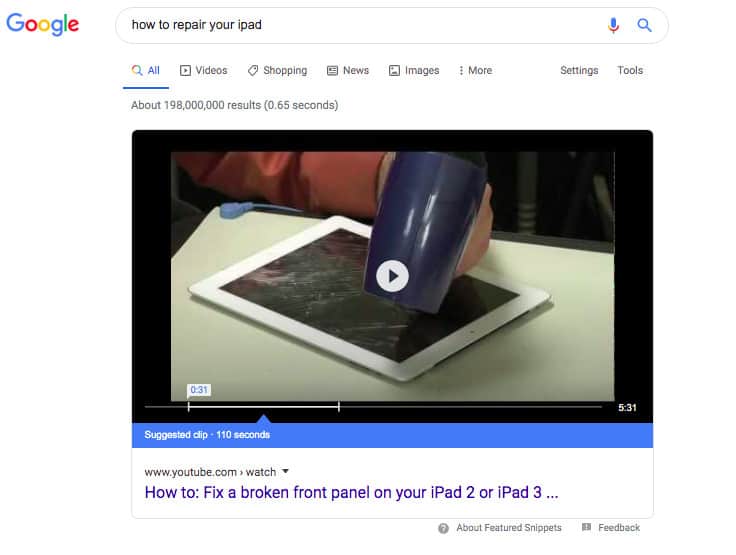
A YouTube Video’s Featured Snippet
Sitelinks Searchbox
If you have site search enabled on your domain, you can have a Sitelinks Searchbox appear by your result, especially when people search for your brand or main keywords.
For example, searching for “etsy” yields their Sitelinks search box. Google provides the option to search Etsy’s site right there because it recognizes the site search markup on the page:

Just as you want as much information loaded into your product data feed for PPC, you want as much relevant structured data on your product pages as possible for SEO.
Overall, the more information you add to your schema markup, such as contact info and company heads, the more chances that information will turn up in search results (and in your PPC ads too).
The biggest brands already have their individual products in Google’s Knowledge Graph, such as this Knowledge Graph products result for “nintendo switch”:
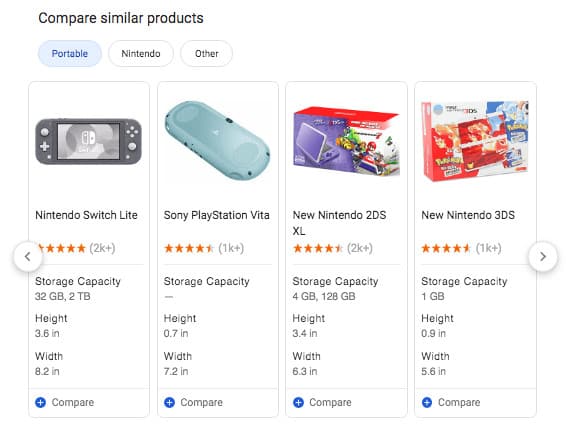
You can even compare products right in Google.

This is the direction Google seems to be going, so make sure your products get recognized by Google too.
Note: Google’s guidelines for structured data outlines their preferences for how developers should implement each type of markup data.
Ready to Supercharge Your eCommerce Sales?
With these 10 eCommerce marketing strategies, you’re well-equipped to increase sales.
The key thing is prioritize and implement them in your marketing plan, and that’s where eCommerce stores often need some help.
Our agency helps medium to large eCommerce businesses grow through PPC, SEO, and CRO.
Note: Want to schedule a consultation with us to see which marketing strategies your store should implement first? Get in touch.
 from Inflow https://ift.tt/3dEA20f
from Inflow https://ift.tt/3dEA20f via IFTTT
via IFTTT
No comments:
Post a Comment